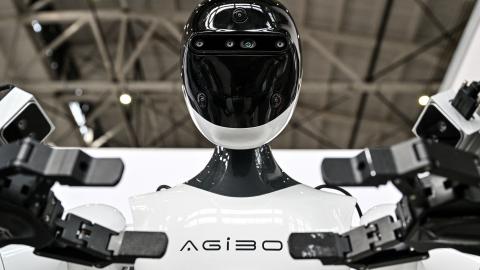In 2025, violent incidents involving robotic systems caught the public eye. In June, pre-positioned Israeli drones attacked Iranian air defenses and missile launchers as part of Operation Rising Lion.1 Ukraine ran a similar operation in May. In Operation Spiderweb, Ukrainian intelligence agents targeted Russia’s strategic bombers with cheap drones that they had smuggled deep into Russia in commercial trucks.2 In other notable cases, humans attacked robots. In June, demonstrators in Los Angeles used the Waymo app to draw self-driving vehicles to their location, then set the cars on fire.3
Other cases were peaceful and even amusing. In April, a pack of humanoid robots ran a half-marathon in Beijing. Unlike their human competitors, the robots required multiple battery changes throughout the race. Less than 30 percent of the robots completed the race, and several required human assistance to finish.4
Despite their obvious differences, these instances jointly underscore the ubiquity of embodied artificial intelligence (AI). Humans have used robots in everyday life for decades, from ovens and microwaves to cars and planes. But AI has introduced the possibility of autonomous robots—machines that can perform tasks with minimal to no human involvement. Though current attack drones depend mainly on human guidance, both the United States and China are training drones to strike autonomously.5 Self-driving cars operate at a higher degree of autonomy, and their goal is to replace a human being with AI as the decision-maker inside the vehicle. Humanoid robots, meanwhile, present an even bolder proposition: replacing human workers with robots that approximate human features but exceed humans in strength and intelligence.
Robots today are a far cry from the Skynet of the Terminator franchise or Hal from 2001: A Space Odyssey.They are not self-aware, nor are they capable of functioning like humans in human environments. Some believe dystopian science fiction could become reality. In a conversation with Senator Ted Cruz (R-TX) in March, Elon Musk made several startling predictions: “I think in 10 years, based on the current rate of improvement, AI will be smarter than the smartest human.” Musk went on, “There will be ultimately billions of humanoid robots. All cars will be self-driving. . . . In 10 years, probably 90 percent of miles driven will be autonomous. . . . In five years, probably 50 percent of all miles driven will be autonomous.” Most concerningly, when Cruz asked about the likelihood of a doomsday AI scenario where robots unite to annihilate humanity, Musk responded dryly, “20 percent likely, maybe 10 percent . . . [within] five to 10 years.”6
Amid AI competition with the People’s Republic of China (PRC), US policymakers should soberly weigh these risks. The likelihood of robots gaining consciousness and destroying humanity is small.7 But there is a far more likely scenario: an adversarial regime will exploit its AI advantage to steal proprietary technology from US companies, sabotage critical infrastructure, and spy on or attack Americans. The Chinese Communist Party (CCP) is currently waging multi-domain political warfare against the United States. It is encouraging the flow of fentanyl into the US to kill Americans,8 and it shapes America’s social media ecosystem by spreading disinformation and divisive narratives through TikTok and other apps.9 Furthermore, CCP agents within the United States have targeted America’s food supply with agroterrorism.10 With Beijing threatening US interests across domains, America cannot afford to also allow China to achieve dominance in AI and the global robotics supply chain—both because of the CCP’s malign intent and because of the transformative nature of these technologies.
AI and Robotics: Already, and Not Yet
Artificial intelligence uses computers to accomplish tasks with some level of human involvement. In the short run, successful AIs will make life easier for humans. ChatGPT, the popular chatbot from OpenAI, has met this objective. It was rapidly adopted across industries and became one of the internet’s most popular websites in 2025.11 But AI can be used for more than large language model chatbots. Embodied AI can process audio, visuals, and text, make decisions based on this, and act upon the world.
Americans are familiar with devices like the Roomba, a vacuum that uses sensors to navigate indoor environments. Technologies of this caliber are known as “weak AI.” On the higher end, Swiss company ANYbotics has developed the robo-dog ANYmal, which is optimized to conduct quality inspections of oil rigs and power substations under adverse weather conditions.12 Unlike a Roomba, which sells for hundreds of dollars, ANYmal costs hundreds of thousands. For large companies, however, the robot’s up-front cost translates into quick savings because it can work around the clock and replace human labor in hazardous environments.
Between these extremes is AIGEN, an American robotics company that specializes in agriculture.13 Its robot ELEMENT is designed to weed crop fields in place of human laborers. Multiple ELEMENT robots can communicate with one another and coordinate their movements as they autonomously detect and eliminate weeds, saving time and decreasing labor costs.
Boston Dynamics’ Spot robo-dog is designed to inspect factories and warehouses, though it can function outdoors. It is also equipped to investigate hazardous situations like bomb threats and chemical, biological, or even nuclear calamities.14
Another class of robots, manufacturing robots, is of particular geopolitical importance. Bright Machines, based in San Francisco, designs and builds high-end manufacturing robots powered by proprietary AI models. These machines go beyond automated manufacturing. Their Bright Designer AI software analyzes outputs and offers design recommendations to make automated manufacturing more efficient.15 This capability is increasingly relevant as the US works to decouple critical supply chains from the PRC.
Robots will increasingly replace human labor. But they cannot replace human reasoning. Every day humans gain knowledge, solve problems, and make decisions. Each of these acts is an expression of free will. Artificial general intelligence (AGI) could one day enable computers to simulate and ultimately surpass human cognition. AI seeks to replicate that autonomy and ultimately, as IBM puts it, “replace the need for human intelligence or intervention.”16 That objective is the essence of AGI—the ability to use previously acquired knowledge and skills to autonomously execute new tasks in new contexts.
Humanoid robots embody the pursuit of AGI. Unlike weak AI robots like ANYmal, Spot, and ELEMENT, which are tailored for specific environments, humanoids are built to adapt to everyday life. Tesla describes the mission of its humanoid Optimus as “performing tasks that are unsafe, repetitive, or boring,” ranging from vacuuming and ironing to stirring food and watering plants.17 Boston Dynamics intends its humanoid Atlas to be “commonplace” in human life.18 These aspirations could become reality within the decade. Morgan Stanley projects that humanoids will see a sharp increase in usage in the mid-2030s, and that nearly a billion humanoids could be in commercial or industrial use by 2050. Household adoption could take longer due to high prices, technological roadblocks, government regulations, and societal unease.19
Humans are beginning to adjust to the presence of embodied AI. But it has not reached its promised potential. All these robots run on weak AI, learn from human-curated data, and perform a defined set of tasks. If technology companies develop AGI, Musk’s bullish predictions could come to pass.
Economic Impact of Embodied AI
AI-enabled robots are already changing the world. As technology improves and production costs fall, adoption of these machines will increase. Robots are already replacing human labor in factories, power substations, oil and gas rigs, and other hazardous environments, decreasing insurance and labor costs. Moreover, the sensors in these robots will work with software to forecast repair schedules more accurately. According to Deloitte, AI-powered predictive maintenance could save companies up to 30 percent on upkeep, extend machine lifespans by years, and reduce energy costs.20
Labor shortages are also driving demand for embodied AI. It is not a coincidence that the North American robotics market saw a massive spike when workers were quarantining at home amid the COVID-19 pandemic.21 The end of the pandemic has not brought an end to the labor shortage. According to the International Road Transport Union, there was a global shortage of three million truck drivers in 2024. The International Federation of Robotics noted the same year that warehouses and docks are also struggling to hire enough workers.22 These trends underscore the connectedness of different kinds of embodied AI. Self-driving trucks and humanoid factory inspectors serve different functions along the supply chain. But both solve the same problem.
Global population trends are also driving interest in embodied AI. Shortly before the pandemic, researchers at the Massachusetts Institute of Technology and Boston University found “that countries undergoing more rapid aging—measured as an increase in the ratio of workers above 56 to those between 21 and 55—invest more in robotics.” This trend is most prominent in Germany, Japan, and South Korea.23 Given the broad favorability of robotics and automation among Generation Z employees, this trend will likely continue.24
The humanoid robots that periodically make waves on social media are but one small element in the broader suite of embodied AI. Other forms of robots are already changing the manufacturing sector. These robots will continue to transform the global economy as unit production costs fall. The nation that dominates embodied AI in the next decade will have a considerable economic advantage.
Embodied AI and Great Power Competition
The Nuclear Example
Generational leaps in technology also have profound effects on warfare. During World War II, both the US and Nazi Germany recognized the military application of nuclear power. German chemists discovered nuclear fission in 1938, and the race to develop nuclear weapons commenced. In 1939, Albert Einstein sent a letter to warn President Franklin D. Roosevelt about the deadly potential of nuclear technology, as well as Berlin’s intentions. Germany, Einstein cautioned, had placed export controls on uranium in Nazi-occupied territory and was replicating American research at the Kaiser Wilhelm Institute in Berlin.25 The implications were clear: the Nazis were hoarding critical nuclear materials in a race to create an atomic bomb. The Manhattan Project started as a $6,000 research program in 1940 but grew within five years to a $2 billion whole-of-society initiative.26 Adjusted for inflation, an equivalent program today would have a budget of $24 billion.27
A variety of factors precipitated Washington’s victory in the race to the bomb. Despite its hoarding, Germany struggled to maintain a sufficient supply of uranium or heavy water for its reactors. The Nazis also had a talent problem. Many of the scientists they needed for their nuclear program were Jewish and Polish victims of Adolf Hitler’s political persecution. Moreover, Hitler struggled to understand the project and neglected to fund it properly. Most importantly, the German scientists assigned to the effort did not support it. One such scientist, Carl Friedrich von Weizsaecker, said, “I believe that the reason we didn’t do it was because all the physicists didn’t want to do it, on principle. If we had all wanted Germany to win the war, we would have succeeded.” By 1942, Hitler had cut political support for the program.28 But that same year, the Soviet Union’s State Defense Committee took its first official steps toward developing the bomb.29
Had Moscow achieved the bomb before Washington, the second half of the twentieth century would likely be a story of global totalitarianism. A nuclear monopoly would have allowed Josef Stalin to shape the post–World War II order in Europe in his favor, casting the Soviet Union’s shadow further west. Winston Churchill barely managed to protect the Mediterranean from a non–nuclear armed Stalin’s predations.30 Such a feat would have been impossible had the Soviets possessed the bomb. Moreover, atomic weapons allowed America to secure Imperial Japan’s surrender without the intervention of Soviet forces, thus strengthening Washington’s hand in postwar negotiations.31 Winning the race to the bomb by no means guaranteed America’s victory in the ensuing Cold War. But it kept Western Europe free of Soviet influence and curtailed Moscow’s designs in East Asia.
A Modern Manhattan Project
This history merits consideration as the US and the CCP race for AI dominance. Unlike Hitler, Xi Jinping understands the military potential of this revolutionary technology. In 2015, Beijing’s Made in China 2025 blueprint identified robotics as a key industry.32 In 2017, China’s State Council published a directive that underscored AI’s power to “profoundly change human society and life” and declared Beijing’s intent to “build China’s first-mover advantage in the development of AI.” The document recognized AI’s economic impact on multiple industries, from manufacturing and agriculture to logistics and elder care. China would become “the world’s primary AI innovation center” by 2030, Beijing declared.33
The State Council is similarly forthcoming with its belief that AI is a critical tool in great power competition:
AI has become a new focus of international competition. AI is a strategic technology that will lead in the future; the world’s major developed countries are taking the development of AI as a major strategy to enhance national competitiveness and protect national security. . . . At present, China’s situation in national security and international competition is more complex, and [China] must, looking at the world, take the development of AI to the national strategic level with systemic layout, [and] take the initiative in planning . . . to create new competitive advantage, opening up the development of new space, and effectively protecting national security.
Understanding the CCP’s approach to AI and robotics begins with grasping its conception of national security. China’s 2015 National Security Law defines national security as “the relative absence of international or domestic threats to the state’s power to govern, sovereignty, unity and territorial integrity, the welfare of the people, sustainable economic and social development, and other major national interests.”34 Whereas America’s traditional approach to grand strategy seeks to mitigate threats, the CCP’s approach seeks to eliminate threats. According to Peter Mattis, president of Jamestown Foundation, this “unlimited view” of national security “pushes the Chinese Communist Party toward preempting threats and preventing their emergence.”35 It is no surprise, then, that the CCP has already begun to use AI and robotics to eliminate challenges both abroad and at home to its single-party dictatorship.
China’s Rising Use of Military Robotics
The China-Cambodia joint military exercise Golden Dragon 2024 featured a robo-dog with an automatic rifle affixed to its back. Beijing incorporated similar systems in exercises with Laos, Malaysia, Thailand, and Vietnam in 2023. It has also armed aerial drones with automatic weapons.36 A People’s Liberation Army (PLA) soldier characterized such robots as a replacement for human soldiers in urban reconnaissance and strike missions.37
The PLA is integrating embodied AI—specifically, humanoid robots—into its warfighting because it sees three main advantages to robotics in warfare:
- Versatility. According to Wang Yonghua, a researcher at the Operational Theories and Regulations Department at the PLA’s Academy of Military Science, “Compared with other unmanned systems, humanoid robots are closer to humans in shape and structure, can simulate various human activities, better realize human-computer interaction, and are more suitable for replacing humans to complete complex tasks.”38 Scholars at China’s National University of Defense Technology also noted that twenty-first-century battlefields are increasingly urban and human-centric, which favors humanoid integration.39
- Scalability. As the saying goes, quantity has a quality all its own. In 2023, researchers at the China Association for Science and Technology identified the battlefield impact of humanoid swarms: “The effect and power of a humanoid robot in attacking actions are very limited, but the large-scale use of humanoid robots to form clusters can achieve a leap in attack capabilities.”40
- Survivability. According to PLA Daily’s Zhang Yicheng, humanoids can more effectively draw enemy fire away from soldiers and even sacrifice themselves to protect human combatants.41 The PLA is already weighing this feature’s utility in the context of a Taiwan invasion, wherein casualty-heavy, block-by-block urban warfare is likely. According to another analyst, “The biggest obstacle for China to complete the great cause of reunification in the future is the risk of personnel losses in the street fighting on the island of Taiwan.”42 Therefore, Beijing may plan to rely on humanoid robots, which are uniquely suited for urban warfare, in the event that blockade operations and amphibious landings are insufficient to subsume Taiwan.
The CCP is also integrating embodied AI into its internal security functions. One month after Boston Dynamics’ Atlas showcased its breakdancing moves,43 China’s leading robotics company, Unitree, announced the world’s first humanoid robot boxing match.44 The juxtaposition—the American robot dances and the Chinese robot fights—is revelatory. The CCP views robotics the same way it views all technology: as an extension of political power and policing. Mao Zedong infamously observed that “political power grows out of the barrel of a gun.”45 Robots are merely the party’s newest bullets.
In Mianyang, a city in Sichuan, humanoid robots help manage rush-hour traffic from 8:00 a.m. to 5:00 p.m.46 In Hangzhou and Wenzhou, a spherical robot called the Rotunbot RT-G has accompanied police patrols. According to China Global Television Network, “Its mobility allows it to access areas where traditional patrol equipment cannot reach.”47 The RT-G can reach speeds of 21 miles per hour in 2.5 seconds and carries equipment, including a net gun. It can operate continuously for 10 hours and is designed to function under hazardous conditions. According to the Global Times, companies in the United Arab Emirates have expressed interest in this robot.48
This revelation presents a challenge for US policymakers. Washington and Abu Dhabi recently announced a partnership that would see a massive data center built in the UAE in exchange for Emirati investment in the United States. The deal underscores the Trump administration’s intent to diffuse American AI technology in key nations and regions to box out Chinese competitors. But Washington should expect nations to seek a both/and policy, wherein they aim to benefit simultaneously from American AI compute capacity and Chinese embodied AI capabilities. This likely scenario introduces the concerning possibility that Chinese robots and American AI models will run side-by-side. In many such nations, US officials will not be able to guarantee data security or prevent China from co-opting American advancements.
China’s indigenous AI systems also merit concern. DeepSeek’s R1 model is programmed to avoid topics the CCP deems sensitive. It censors its own responses to questions about Xi, the party’s zero-COVID policies, Beijing’s position on the Russia-Ukraine War, and China’s authoritarian control over citizens’ internet access.49 If China globally propagates its compromised AI systems, Beijing will have a stranglehold on discourse about the country and the party. It will also gain the technological high ground to wage information warfare—as it already does with TikTok.50 A regime that brazenly censors religious texts and conceals its own history cannot be trusted with global AI dominance.51
America and China Are Running the AI Race Differently
The nation that wins the AI race will establish a dominant position in all downstream industries, including robotics and embodied AI. But the US and the PRC are pursuing different innovation strategies, which are premised on competing theories of victory.
AI advancement is a function of three main factors: (1) access to high-end chips, to increase computing capacity; (2) power generation, to support data centers; and (3) human talent, to build and train models. The US is currently pursuing a simple theory of victory: limit Beijing’s computing capacity by restricting its access to high-end graphic processing units (GPUs). Data centers rely on these chips to run advanced models. Smaller chips developed by NVIDIA and fabricated by the Taiwan Semiconductor Manufacturing Company can run more computations in less time at lower energy costs. The nation with greater access to cutting-edge semiconductors will therefore have a better chance of developing AGI.
Washington’s export controls have been largely successful. As of June 2025, Amazon, Google, and Microsoft operated 87 AI data centers, compared to 39 centers operated by Tencent, Alibaba, and Huawei.52 China’s data hubs are generally reliant on US chips, a dependency the Trump administration has exploited by prohibiting NVIDIA from selling select types of semiconductor to the PRC.53 Thus far, in part due to these export controls, US chipmakers have maintained the upper hand in computation, efficiency, energy, and size.
Unfortunately, Beijing has an upstream advantage over Washington: China’s monopolization of refined rare earth minerals. NVIDIA chips rely on dysprosium, a mineral used in semiconductor capacitors. The PRC refines 99.9 percent of the global supply of dysprosium, primarily at a facility in Wuxi, China.54 This gives Beijing the ability to restrict America’s access to this mineral and throttle US chip production. Today, China could not take this step without harming itself significantly because Beijing relies on smuggled chips from companies like NVIDIA. But if the PRC catches up in chip manufacturing, China could exploit this asymmetry.
In the short run, Beijing aims to compensate for its computation limitations by ensuring Chinese companies deploy AI faster than their American competitors. In 2021, China surpassed America in use of factory robots per 10,000 workers. In 2022, it broke even with Japan. By 2023, the PRC had surpassed Germany. Chinese companies are also on track to account for more than half of global humanoid robot production in 2025.55
In contrast to America’s high-energy/high-cost approach to AI innovation, Beijing is pursuing a low-energy/low-cost strategy that prizes diffusion and adoption above computing breakthroughs. Beijing continues to evade US export controls to access the advanced semiconductors needed to develop AGI. But it is more focused on subsidizing its robotics companies to bring innovations to market as quickly as possible.
This gambit should sound familiar to US policymakers. Beijing used the same strategy in telecommunications: dominate the global market by subsidizing Chinese enterprises to undercut global competition. For example, Huawei acquired Western intellectual property. Then it diffused its technology around the world at artificially low prices, which were made possible by state subsidies.56 Other PRC companies like the drone manufacturer DJI have achieved similar dominance. The latter case is so severe that local law enforcement agencies across the United States oppose federal efforts to ban future acquisitions from the Chinese company.57
Recent decisions from the Trump administration, however, will compound these challenges. On July 14, 2025, US government officials reversed a prior decision to restrict NVIDIA’s ability to sell H20 AI chips to China.58 These semiconductors are less capable than NVIDIA’s most advanced GPUs, but they are superior to Huawei’s products and possess significant memory capabilities that support AI inference.59 Deft lobbying from US industry has weakened one of Washington’s greatest advantages over Beijing in the AI race.
Identifying Embodied AI’s Chokepoints
In some cases, the PRC’s supply-dominance strategy is succeeding. Agriculture-focused US robotics companies cannot acquire motors, batteries, and solar panels from non-PRC suppliers at acceptable cost.60 Still, past need not be prologue. The robotics industry is early in its development. In telecommunications, Washington ran into the so-called Huawei problem. Policymakers recognized the threat Huawei’s technology posed to Western democracies only after the PRC firm dominated the industry. This time, the US is working to address supply chain issues before China has established decisive control.
The West has the advantage in producing two key components in humanoid robot production: ball screws (which convert between rotary and linear motion) and sensors (which enable robot positional and environmental perception). A recent Morgan Stanley report found that European and Japanese companies such as Rollvis, SKF, and NSK dominate high-end ball screw production. Chinese manufacturers like Hengli and Best are growing, but they currently depend on Japanese- and European-produced screws and grinding machines. According to a recent Chinese industry report, ball screws for humanoid robotics are one of China’s most acute Western hardware dependencies.61 Regarding sensors, US-based ATI (part of Novanta) remains a leader, though Chinese players like Kunwei and Sunrise Instruments are on the rise.
Western policymakers cannot rely on these advantages indefinitely. China is working to establish domestic sources for humanoid components. Several even have US subsidiaries working on screw and sensor manufacturing. Hengli has a marketing and manufacturing base in Bolingbrook, Illinois. In a 2024 LinkedIn post, Hengli America announced its Chinese parent company’s intent to diversify its product portfolio to include ball screws.62 An August 2024 report from Chinese company Guolian Securities suggested that Hengli’s ball screws could enter Tesla’s supply chain for its Optimus humanoid once Hengli scales up to mass production.63
Sunrise Instruments maintains a subsidiary in Canton, Michigan. The company’s website claims that “machines + sensors will unlock endless human creativity and is [sic] the next stage of industrial evolution.”64 The company manufactures a joint torque sensor for use in surgical robots, humanoids, and other forms of embodied AI.65 Introducing sensors manufactured by PRC manufacturers into American robots presents several risks, including intellectual property theft and component sabotage. These risks have always been a factor when working with Chinese firms. But AI innovations like “digital twins,” which use sensors to generate a digital model of a physical asset for predictive maintenance, compound the threat further.66 PRC-sabotaged sensors could feed false information to US companies to compromise their repair and maintenance schedules. If targeted properly or executed at scale, this long-term sabotage could have serious implications for American supply chains, including those that are critical to national security.
If US robotics companies rely on PRC-sourced components for their products, Beijing will have another leverage point over Washington in one of the most critical technology sectors of the twenty-first century. This dependency would also open multiple threat vectors for US industry and consumers, essentially inviting the Chinese Communist Party into American factories, farms, and living rooms.
Policy Recommendations
US policymakers face a variety of challenges along the embodied AI value chain, particularly amid great power competition against a motivated adversary. Allowing China to dominate this transformational technology or permitting CCP-controlled robots to enter US supply chains threatens the safety of Americans, the competitiveness of US companies, and the security of Washington’s allies and partners. Failing to address dependencies on PRC components could leave American and Western robotics companies at the mercy of Chinese suppliers and allow the CCP to create backdoors into critical systems.
The race to dominate AI and robotics is still in its early stages, and the US and its allies could still prevail. But doing so will require Congress and the administration to make a sustained, bipartisan commitment to enacting industrial policy that hobbles China’s technological advancements and boosts Western competitiveness.
Policymakers in Washington should adopt the following lines of effort:
1. Promote US and allied industry.
- Decouple America’s rare earth mineral supply chain from China. So long as Beijing dominates rare earth minerals refining, the CCP will possess significant upstream leverage over America’s AI and robotics industries. China’s monopoly also gives Beijing political leverage over Washington, as shown by recent tariff negotiations.67 The US will struggle to implement several of the following recommendations unless it breaks free of its rare earths dependence on China. MP Materials operates one of the only US-based rare earths supply chains, with a mine in Mountain Pass, California, and a refining facility in Texas. Washington should insulate MP Materials and other US companies involved in similar work from China’s predatory pricing and ensure their resilience by committing to long-term government contracts. The recently announced Department of Defense investment in MP Materials is an excellent start.68 Elected officials in Washington will need to sustain this support over multiple years in a bipartisan fashion. Policymakers should also revise the authorization for the Development Finance Corporation (DFC) to allow the corporation to invest in developed countries that have considerable rare earth mineral deposits, like Canada.69
- Revise equipment subsidy policies for robotics companies. Manufacturers already benefit from tax exemptions, particularly when purchasing heavy machinery. Washington can help US robotics companies by broadening these exemptions. Companies expend significant capital on robotics software, which often involves an expensive subscription. Policymakers should expand subsidies to help defray these costs.
- Build on prior US government efforts to support domestic battery manufacturers. Reliance on Chinese-produced batteries threatens US companies across sectors, including in robotics. Washington has begun to succeed at unraveling this dependency. In 2022, the Department of Energy (DOE) announced a $107 million loan to Australia’s Syrah Resources to stand up a graphite production facility in Louisiana.70 In 2023, the DFC approved a $150 million loan to Syrah for its Balama graphite mine in Mozambique.71 The following year, the DOE awarded a $220 million grant to the Louisiana plant. These investments helped position Syrah as the only large-scale, vertically integrated graphite producer outside China.72 Even so, automotive companies in America have been slow to certify Syrah batteries for use. China has historically overproduced critical components to price Western competitors out of the market, most notably Solyndra during the Obama administration.73 The US should protect its indigenous companies—and its public investments—from China’s predatory pricing by prohibiting American companies from purchasing PRC-made batteries.
- Strategically deploy public and private capital. Venture capital (VC) has been instrumental in fueling America’s AI boom. But manufacturing companies often find themselves in a bind with VC funding: high valuations that exceed early revenues. Private equity firms expect a high rate of return, and manufacturing firms often cannot meet those expectations. Government investing bodies, particularly the Department of Defense’s Office of Strategic Capital (OSC), can play an important role by providing up-front financing to robotics companies at a lower interest rate. Congress should increase funding for OSC to boost support for America’s manufacturing and robotics industries that lie downstream from AI investments.
- Waive tariffs on key allies and partners that are part of the global robotics supply chain. Tariffs can be a powerful negotiating tool to bring manufacturing capacity back to the United States. But they can also increase domestic prices for foreign components. The Trump administration should waive tariffs on any critical robotics inputs that do not come from the PRC.
2. Insulate the US homeland from PRC robotics.
- Ban the purchase and deployment of CCP robots in the United States. Members of Congress have already introduced legislation along these lines. Senator Josh Hawley (R-MO) authored the Decoupling America’s Artificial Intelligence Capabilities from China Act of 2025, which would ban US companies from engaging with the PRC on AI technology imports or exports.74
- Prohibit US companies from purchasing PRC components for robotics and other AI applications. Policymakers should block Chinese components from entering the United States. In the short term, inputs like sensors and actuators will be easier to replace. Building a de-risked supply chain for batteries and solar panels may require a longer time horizon. But Congress should lock in those prohibitions promptly and send a demand signal to non-Chinese suppliers.
- Protect energy generation that supports AI models. Reuters found that the US is heavily reliant on PRC-produced inverters to connect solar and wind energy to the power grid. These components are a material threat to America’s critical infrastructure. According to the report, hostile agents could “skirt firewalls and switch off inverters remotely” and “trigger widespread blackouts.”75 For obvious reasons, a CCP-controlled off-switch to the US power grid endangers the American people. But the possibility China will target energy infrastructure that supports AI data centers adds another layer of risk amid the critical technology race. Policymakers should ban US electric companies from purchasing PRC-made inverters and work to rip and replace existing components across the US.
- Ban PRC-based firms from establishing AI or robotics subsidiaries in the United States. The US government needs to protect American companies from China’s predatory pricing and state-backed intellectual property theft. Allowing Chinese robotics companies to operate within America increases both risks. The Committee on Foreign Investment in the United States (CFIUS) should block all future mergers and acquisitions involving PRC AI and robotics companies.
- Force Chinese parent companies to divest from all robotics firms operating in the United States. Congress should pass legislation modeled on the 2024 TikTok legislation and mandate that PRC-owned companies divest from subsidiaries operating in the US.76
3. Deny PRC access to critical US technologies.
- Strengthen US export controls on semiconductors. In 2024, DeepSeek Chief Executive Officer Liang Wenfeng confirmed the effectiveness of US export controls: “Money has never been the problem for us; bans on shipments of advanced chips are the problem.”77 In 2025, Tencent Vice President Wang Qi reiterated this challenge: “The most severe problem is the [limited] resources of [graphics] cards and computing resources.”78 Despite the broad success of export controls, the CCP has successfully smuggled advanced semiconductors into China through front companies and transshipping. The Trump administration should retain and strengthen existing export controls. But Congress also needs to pass new legislation mandating trackers on AI chips to identify and crack down on problematic actors. Representative Bill Huizenga (R-MI) and Senator Tom Cotton (R-AR) have introduced the Chip Security Act, which would mandate location verification mechanisms on GPUs within 180 days of enactment.79 More fundamentally, the Trump administration should reapply export controls on H20 semiconductors and other advanced chips. Equipping the adversary is an elementary mistake in grand strategy, and it is telling that private sector actors like NVIDIA, not national security professionals, advocated for this policy. America’s superior computation power is its greatest advantage over China in the AI race. Policymakers should protect this asymmetry jealously.
- Levy export controls on humanoid robot supply chain chokepoints. The United States and its allies should capitalize on the PRC’s reliance on Western components for its embodied AI systems. But time is limited, as China is working to eliminate these dependencies. Washington should control exports of vital components like ball screws and sensors and work to gain the support of key allies like Japan and Germany.
- Work with partners on AI while protecting US technology from Chinese smuggling or theft. Washington’s AI partnership with Abu Dhabi could give China access to America’s high-end chips. The UAE approved the construction of a Chinese military facility at its Khalifa port in 2021.80 And, as mentioned earlier, the UAE is interested in acquiring PRC-made robots for law enforcement purposes. US policymakers need to ensure America’s AI partners are not allowing PRC entities to access or steal advanced GPUs.
- Supplement export controls with financial sanctions. Multiple US administrations have failed to enforce export controls. The problem is so grave that law firms routinely advise their clients to violate these laws. The US government should consider levying steeper penalties to incentivize compliance with export controls, including financial sanctions under the International Emergency Economic Powers Act.81
4. Blunt China’s robotics technology export scheme.
- Levy primary and secondary sanctions on AI and robotics companies with known links to the CCP and PLA. In February 2025, General Motors (GM)and Mercedes-Benz both announced they would integrate DeepSeek’s R1 reasoning model into vehicles coproduced with Chinese companies. GM also indicated it would integrate ERNIE Bot, an AI chatbot developed by Chinese firm Baidu.82 In April 2025, BMW made a similar announcement.83 The United States should work to prevent automakers outside China from adopting CCP-controlled AI. Policymakers should levy primary sanctions on DeepSeek, Baidu, and other Chinese-developed AI models to prevent US automakers from integrating them. Washington should also consider implementing secondary sanctions to discourage foreign firms like BMW and Mercedes from integrating this technology into European cars. Policymakers in Berlin may bristle at these measures. After all, Volkswagen constructed and operated an assembly plant and two test tracks in Xinjiang, the region of the CCP’s ongoing genocide of Uyghurs, for twelve years.84 The willful blindness of Germany and other wealthy allies underscores the necessity of American leadership. Without Washington’s sustained initiative, the free world will lose the AI race.
This policy memo was updated to reflect the Trump administration’s decision to allow NVIDIA to sell H20 chips to China.



















